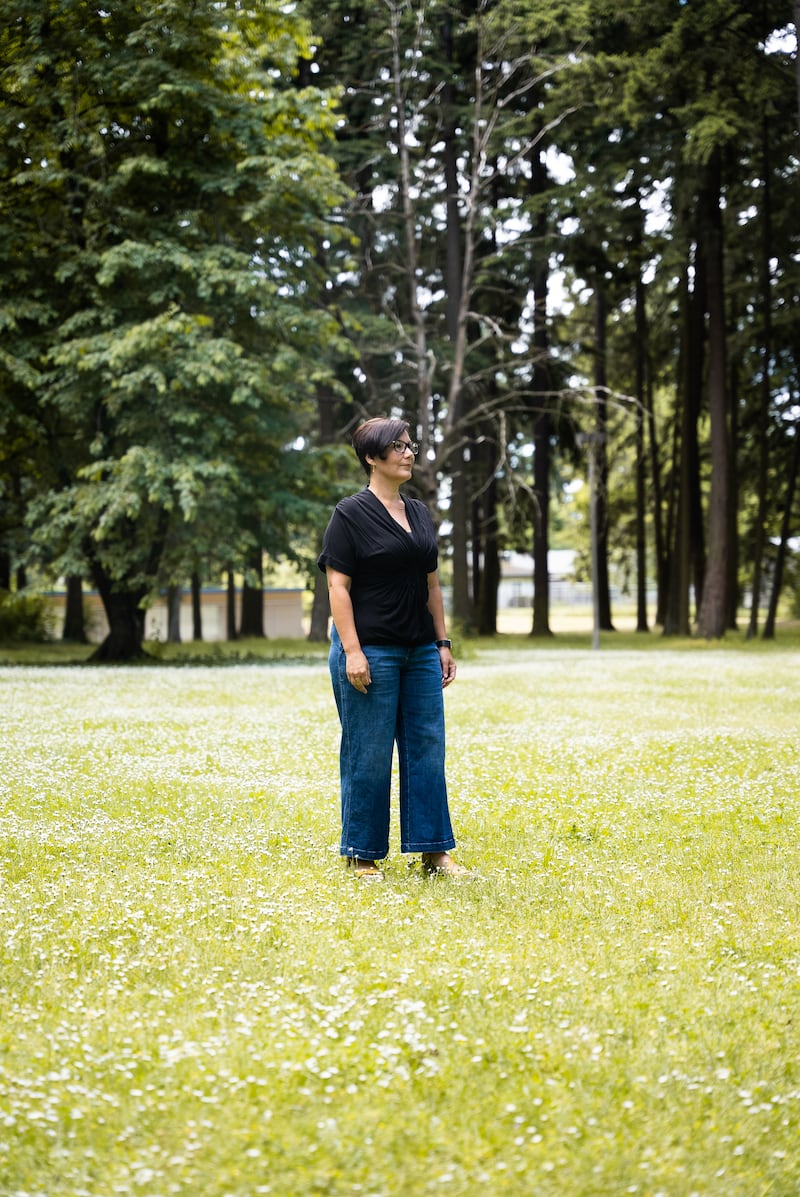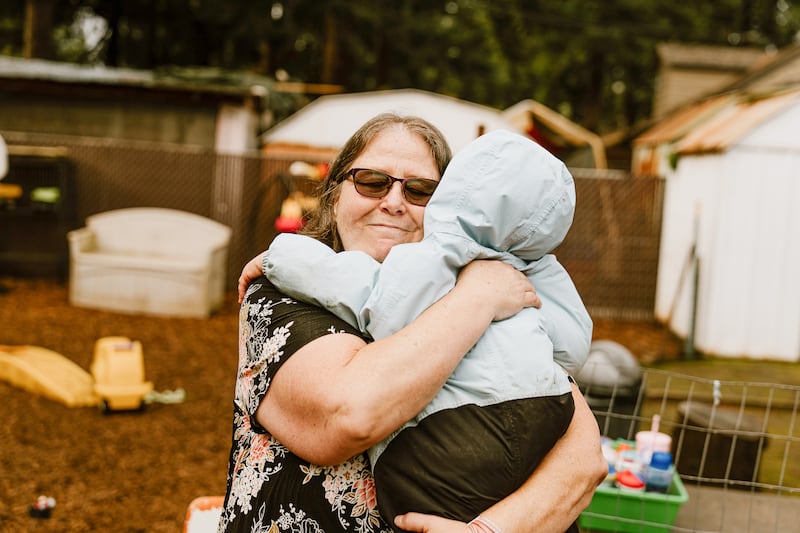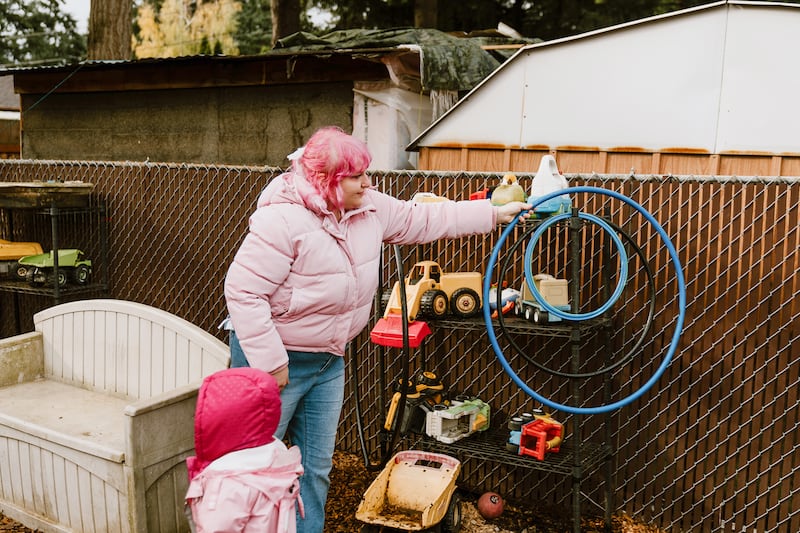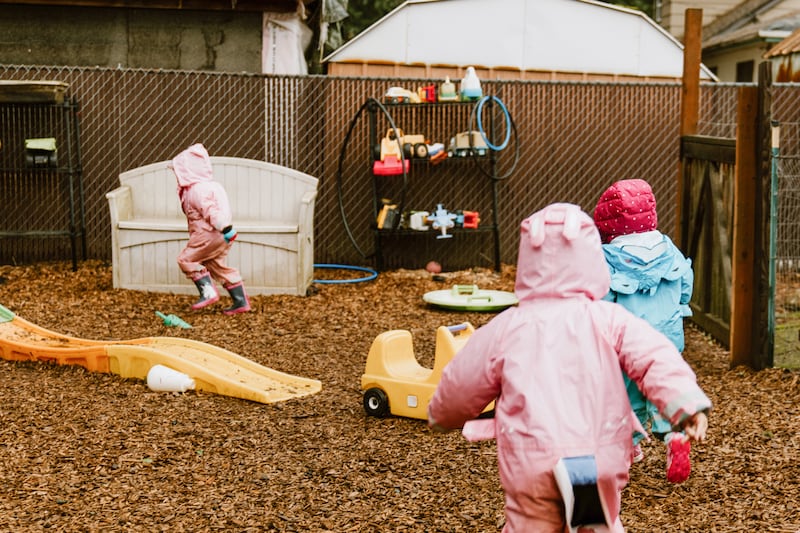Outside a yellow house on Southeast 142nd Avenue, 10 children in yellow, blue and pink rain jackets gambol through a large backyard adorned with a giant plastic airplane, multicolored slides and—the hottest attraction of the month—a growing hole that they take turns digging with a plastic trowel.
None of the families who send their tots to Melody’s Munchkins pay a dime. For these families—all of whom are low-income and most families of color—the impact of free preschool is enormous.
“The stability,” says Melody Norris, who owns Melody’s Munchkins, “is just amazing.”
That was the promise of Preschool for All, the tax on high-income earners that Multnomah County voters passed in the fall of 2020. The pledge? To fund a program that within a decade would provide free preschool to every family living in the county that might want it.
The initiative, which is expected to generate $152 million in tax revenue this year and was championed by Multnomah County Chair Jessica Vega Pederson while she was still a county commissioner, promised to create 12,000 new publicly funded preschool seats by 2030.
But what’s happening at Melody’s Munchkins is also a warning about the long-term prospects of Preschool for All.
The 10 preschool spots at Melody Munchkins existed before the measure’s passage. In other words, the county didn’t create Melody’s Munchkins; it merely subsidized an existing preschool.
To the families receiving the free child care, it’s wonderful. But for families waiting their turn, the distinction matters quite a bit.
A WW review of the program’s spending raises questions whether the county is building enough new capacity to scale up Preschool for All so that it serves, well, all.
In its official planning report in July 2020, the program said it would create 1,500 to 2,000 new publicly funded seats by the 2023-24 school year. Thanks in part to the pandemic, it’s financed only 1,200. More crucially, the county has in two years created only 507 entirely new preschool seats that didn’t exist before the tax.
A WW review of county budget documents, as well as interviews with key figures, shows that Preschool for All, just like the county’s share of Metro’s massive homeless services measure, has vastly underspent its budget. It’s created few seats that didn’t exist before the measure and has failed to spend dollars on the most stubborn problems that the program promised to address.
Vega Pederson, who is under duress these days for the county’s flagging response to homelessness, disputes the idea that the county is falling behind on her signature achievement.
“Anybody who says that we’re not doing hard work doesn’t know what they’re talking about,” Vega Pederson tells WW. “As we bring more providers into our system, there’s going to be a multiplying effect of them being able to expand their classrooms.”
In truth, there’s been little external oversight of Preschool for All, so all the public can rely on is information the county chooses to divulge. But spending reports, obtained through a public records request, show that the county spent only half of what it budgeted for the program last year.
And the underspending? It’s in the areas most needed to create new capacity. Most notable: The program spent none of the $8 million the county set aside for creating entirely new preschool seats.
“Everybody has an interest in making sure the public sector services are delivered effectively and efficiently,” says local economist Joe Cortright, who adds that the county’s struggle to spend its tax dollars is a recurrent theme. “This is something that people should be concerned about, and it’s something the county ought to be very responsive to.”

WHAT DID THE MEASURE PROMISE?
In 2018, Vega Pederson had big plans, both for herself and for county parents. As a county commissioner from East Portland’s low-income Hazelwood neighborhood, she came to office as a champion for the county’s have-nots, and she received steady support from the nonprofits that provide a social safety net.
Vega Pederson, now 48, was in her second year as county commissioner but was already eyeing a run for county chair. She needed a signature initiative, and she set her sights on a shiny object: universal preschool. Portland’s chapter of the Democratic Socialists of America had proffered a similar idea, and Vega Pederson wrangled it into the measure that appeared on county ballots that November.
“For a commissioner to have done really deep community work, to be building a program that’s going to be a game changer, and doing it as a commissioner and not as a chair,” Vega Pederson reflected recently, “that was a really big thing.”
In the fall of 2020, Multnomah County voters approved Measure 26-214 by almost 2 to 1, agreeing to tax high-income earners so every 3- and 4-year-old in the county could attend preschool for free within a decade.
It wasn’t a novel idea. Other blue cities (New York City and Washington, D.C.) had implemented similar programs, and both had enjoyed accolades—but they weren’t funded by an income tax.
Multnomah County’s premise was progressive: tax 1.5% of taxable income over $200,000 for joint filers ($125,000 for single filers) with another 1.5% on income over $400,000 for joint filers ($250,000 for single filers). With that money, the county would create new preschool classrooms, subsidize existing ones, offer teachers higher pay (between $19.91 and $37 an hour), and expand the system by adding 12,000 “publicly funded” preschool slots by the year 2030, according to county officials. Unlike a bond or levy, there was no expiration date on the tax—it is never supposed to end.
The program would in the first couple of years prioritize families of color, low-income families, and children with developmental disabilities.
Perhaps most importantly, the program would remove one of the biggest barriers to wealth creation for working moms: lack of child care.
“Parents who are unable to afford preschool aren’t able to work as much as they’d like to, and the U.S. has been falling behind in women’s labor force participation,” says Dr. Mary King, a professor emerita of economics at Portland State University who researches early childhood services. “When women don’t work, we end up with higher poverty rates for older women. This program will make a big difference.”
The program also promised to stabilize an extremely unstable industry. Over time, money raised by the tax would combat the two biggest hurdles faced by the early childhood services industry: a lack of teachers and a shortage of physical classroom space.

WHERE WAS THE MONEY SPENT?
Multnomah County started collecting the tax in 2021. Like fishermen who luck into a Pacific school of king salmon, officials could barely believe what they hauled in.
In its first year of tax collection, Preschool for All raked in $68 million more than it had projected, bringing the first-year total to $187 million. In its second year, the tax brought in $199 million. County economist Jeff Renfro told officials this spring that the surplus was largely due to higher-than-expected capital gains, or revenue made from selling bonds, stocks or property.
Remarkably, the county has never previously disclosed how the first-year dollars were spent, only how they’d been budgeted.
On Oct. 3, county officials shared documents with WW that revealed a surprise: Preschool for All underspent its first-year budget by almost half. The county budgeted $59 million in its first year and only spent $30 million, according to the figures.
Of that spending, the records revealed, 23 preschools similar to Melody’s Munchkins, in that they were home-based small businesses, received a total of $8.8 million.
Those businesses include success stories.
Melody Norris runs two other homes just like the Melody’s Munchkins preschool on 142nd. Across all three homes, she serves 30 low-income preschoolers. (A fourth preschool Norris just opened this year is located in a converted shed in the Corbett woods.)
For a decade, Norris had run the 142nd Avenue classroom on a razor-thin margin, repeatedly shedding teachers as they sought higher-paying jobs elsewhere. About half of Norris’ families paid out of pocket. The others received a monthly state stipend of $1,000 to pay for preschool. Even the families paying privately, though, Norris says, “were holding on by a thread.”
Preschool for All changed all that. “I thought it was amazing that preschoolers were going to get to go to school for free,” Norris says. “I saw the benefits of the program and I said, ‘I’m on it.’”
Norris is now paid between $15,600 and $21,840 per child per year by Preschool for All. All 30 slots are funded by the program. Norris upped the hourly wage for her 20 aides and teachers to between $24 and $28, plus benefits, reducing the temptation to jump ship.
Small, private preschools are what the county pledged to make its top priority.
Backers said in campaign materials that the measure didn’t want to funnel most of its money into “large programs—such as school districts and large centers—that are easier to scale than small centers and home-based settings,” the campaign wrote. They feared such an approach wouldn’t allow small, BIPOC-run preschools to receive adequate funding.
Yet $4.7 million of the first year’s budget went to large child care or community centers. Another $2 million of the program’s first-year budget went to classrooms in the David Douglas, Portland and Parkrose school districts, documents show. Portland Public Schools hosts 120 of the 507 entirely new preschool seats the program created in its first two years. David Douglas hosts 90 of them.
Over half of the seats that didn’t exist before Preschool for All were housed in school districts, which backers said they wished to avoid. (For more on the tensions in one of those districts, see this sidebar.)
Lisa Rau, a senior researcher at the social policy research firm MEF Associates, says seeking volume in the first few years makes sense. “You get the numbers by putting money at schools that already have the infrastructure,” Rau says. Economics professor John Gallup at PSU agrees. “It makes sense to do the easy stuff first,” Gallup says.
There are also huge overhead costs.
In the first year, $5.7 million went to the city of Portland for tax collection; that will be an ongoing expense, costing no more than $6.4 million annually. (For comparison, Metro paid the city $9.3 million last year to collect its homeless tax across three counties.)
The county spent $5 million internally to administer the program, including payroll for 18 program staff.
To onlookers, such high overhead is alarming.
“The costs are extraordinary,” says PSU professor emeritus of real estate Gerry Mildner.

IS THE PROGRAM ON PACE TO MEET ITS GOALS?
What the measure has not done, data shows, is meaningfully expand the preschool system’s capacity. More than half of the Preschool for All-funded seats existed before the tax, just like the ones Norris runs.
Some observers say that’s to be expected with a new program: It will pick the low-hanging fruit first while it builds capacity.
“It’s a silly sort of thing to think is happening too slowly. It’s a brand-new program and they’re being cautious in terms of how they expand, which is smart,” says King, the PSU economics professor. “We don’t just have empty spaces waiting for unemployed people to move into who are ready to provide preschool.”
Preschool for All promises to create 12,000 publicly funded slots by 2030, on top of the estimated 3,000 publicly funded slots that already exist. But the county says it doesn’t know just how many of those 12,000 seats must be entirely new preschool seats, meaning they didn’t exist prior to the tax.
But a 2018 legislative report by the measure’s backers does offer an estimate of how much new capacity must be added: between 260 and 580 new classrooms and 2,300 teachers.
That means Multnomah County will need to add at least 43 new classrooms each year over the next six years to meet its goal for 2030.
Only 18 of the 83 classrooms in which Preschool for All is currently funding slots are entirely new.
Vega Pederson calls the new seats created in two years a “huge win.” (At the time, Vega Pederson thought the number was 350; see this sidebar.) The pace, she says, will only speed up from here.
“We have 10 years to get to universal access,” Vega Pederson says. “As we bring more providers into our system, there’s going to be a multiplying effect of them being able to expand their classrooms.”

WHERE DIDN’T IT SPEND?
Preschool for All underspent its first-year budget by $29 million—and particularly failed to spend on building new facilities and recruiting a workforce.
The program budgeted $8 million in its first year to what it called a “Facilities Fund”: money that existing providers could use to expand the number of preschool seats, either by expanding existing space or finding entirely new spaces.
Yet the program spent not a single dollar of the $8 million Facilities Fund in its first year. Instead, it rolled over the entire fund into the current fiscal year.
Creating new classrooms and expanding existing ones is the first of two basic charges the program is tasked with to achieve universality by 2030. “Throwing money at the problem directly through subsidies isn’t going to solve the lack of access and space,” Rau says. “You have to open up doors around space and access.”
Economics professor Gallup says it’s not “a good idea for them to push the money out the door quickly if the conditions are not right for them yet,” but adds that “it may be an indication that they’re falling behind.”
The program also failed to spend $5 million the county had budgeted in its first year to develop a preschool teacher pipeline. A lack of workforce is the other fundamental crisis the child care industry faces: The number of early child care providers, according to state economic estimates, shrank from 1,200 to 800 in the first two years of the pandemic.
“We are struggling to bring people into this industry, despite the wage,” says Preschool for All director Leslee Barnes. “Fast food was paying $20 an hour, and fast food isn’t going to ask you to do all these things. We’re trying to figure out what will bring people back.”
Vega Pederson says it’s unfair to view the county’s underspending on facilities and workforce as a failure.
“The stubborn things are stubborn for a reason. To expect us to solve this problem in the first two years, that’s not a very realistic statement,” Vega Pederson tells WW. “We’re creating the program from scratch.”
Other places the program underspent or failed to spend in its first year: professional development opportunities for pilot preschools and coaching for pilot classrooms.
In other words, the program failed to spend money to break down the two barriers it needed to overcome most to reach universality.
Multnomah County Commissioner Julia Brim-Edwards says she’s unhappy with the underspending, which is new information to her.
“The program has clearly fallen short of expectations in these two critical areas,” Brim-Edwards says. “With these resources, I and many in the community expect that there would be many new opportunities for our youngest learners.”

WHAT’S NEXT?
Jeff Renfro is the longtime economist for Multnomah County. He has all the attributes of a Portland dad: He transports his children by cargo bike, prefers to wear plaid and, like any good numbers nerd, twinkles when he sits in front of the board of commissioners and explains PowerPoint graphs.
When voters passed the Preschool for All measure in November 2020, Renfro tacked on another task to his job duties: tracking the whereabouts and business dealings of the 100 richest taxpayers in Portland.
That’s because fewer than 100 taxpayers in Portland account for 17% of the $152 million raised annually by the Preschool for All tax.
At a Feb. 7 briefing of the board of commissioners, Renfro said he seeks to “understand who these people are and track them over time.”
That matters because the addition of the preschool tax pushed Multnomah County into a league of few: If you stack all the income taxes on top of one another, the county has the second-highest income tax rate of any large jurisdiction in the U.S., second only to New York City, according to a report from Ernst & Young commissioned by Oregon Business & Industry. But unlike NYC’s highest tax rate, which applies only to incomes over $25 million, Multnomah County reaches its income tax peak for a single filer that makes in excess of $125,000.
And while in its first two years Preschool for All struggled to do the hardest part of its decadelong mission—create new preschools—it now must climb the rest of that hill with disgruntled taxpayers looking on from the sidelines. There, frustrations are mounting at the county’s inability to spend the hundreds of millions of tax dollars it gets to combat the county’s most pressing issues (“They Left,” WW, Feb. 1).
In spring meetings of the Preschool for All advisory committee, Renfro shared concerns about the volatility of the tax and its reliance on so few wealthy Portlanders. “I definitely heard some stories about people who wrote their first Preschool for All check and then left the county,” he said.
Unlike other new tax measures, such as the Metro Supportive Housing Services measure, the Preschool for All tax has no end date. The likely effect of that, Mildner the real estate professor says, is that it will turn away businesses that might otherwise have sought a home in Portland. Trying to revive downtown real estate, he says, “involves convincing rich people to make investments in your city. This tax may change that.”
Vega Pederson now finds herself in the hot seat. Her first 10 months in office have been rife with controversy—most prominently, resisting a corrective action plan Metro placed on the county after four consecutive quarters of underspending its homelessness dollars.
In some ways, those issues are mirrored in the county’s rollout so far of Preschool for All. The county struggled to spend the tax money, and struggled to spend it how it promised it would.
In the meantime, the tax is building an enormous surplus.
Program leaders have always maintained that it needs to frontload tax reserves for the years when the program will cost more to operate than the tax it collects. (In about 15 years, county economists say, the tax and cost of the program will march in lockstep.)
But the tax rate is also set to rise by 0.8% in 2026.
In mid-July, a dozen developers and business leaders ate Potbelly sandwiches from platters alongside Vega Pederson in a downtown office building. They talked to her about homelessness, economic recovery, and the sorry state of Portland’s streets. Among their suggestions: cap the Preschool for All tax, or at the very least don’t raise it in 2026.
According to sources at the meeting, Vega Pederson gently but firmly said no.
Brim-Edwards says the county “risks our credibility and taxpayer support for programs in which we need public support” if it can’t produce stronger results soon.
“We need to have a plan. We need to be taking urgent action. We need to be transparent and show results,” Brim-Edwards says. “That is what rebuilds trust.”

